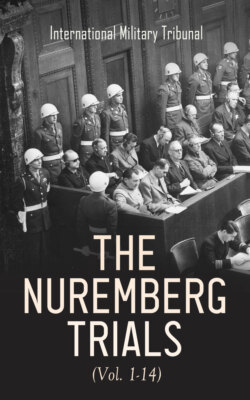Читать книгу The Nuremberg Trials (Vol. 1-14) - International Military Tribunal - Страница 158
ОглавлениеThe affidavit of Kurt Lindown, a former Gestapo official, states: “. . . . There existed in the prisoner of war camps on the Eastern Front small screening teams (Einsatz commandos), headed by lower ranking members of the Secret Police (Gestapo). These teams were assigned to the camp commanders and had the job of segregating the prisoners of war who were candidates for execution according to the orders that had been given, and to report them to the office of the Secret Police.”
On 23 October 1941 the camp commander of the Gross Rosen concentration camp reported to Müller, Chief of the Gestapo, a list of the Soviet prisoners of war who had been executed there on the previous day.
An account of the general conditions and treatment of Soviet prisoners of war during the first eight months after the German attack upon Russia was given in a letter which the Defendant Rosenberg sent to the Defendant Keitel on 28 February 1942:
“The fate of the Soviet prisoners of war in Germany is on the contrary a tragedy of the greatest extent . . . . A large part of them has starved, or died because of the hazards of the weather. Thousands also died from spotted fever.
“The camp commanders have forbidden the civilian population to put food at the disposal of the prisoners, and they have rather let them starve to death.
“In many cases, when prisoners of war could no longer keep up on the march because of hunger and exhaustion, they were shot before the eyes of the horrified population, and the corpses were left.
“In numerous camps, no shelter for the prisoners of war was provided at all. They lay under the open sky during rain or snow. Even tools were not made available to dig holes or caves.”
In some cases Soviet prisoners of war were branded with a special permanent mark. There was put in evidence the OKW order dated 20 July 1942 which laid down that:
“The brand is to take the shape of an acute angle of about 45 degrees, with the long side to be 1 cm. in length, pointing upwards and burnt on the left buttock . . . . This brand is made with the aid of a lancet available in any military unit. The coloring used is Chinese ink.”
The carrying out of this order was the responsibility of the military authorities, though it was widely circulated by the Chief of the SIPO and the SD to German police officials for information.
Soviet prisoners of war were also made the subject of medical experiments of the most cruel and inhuman kind. In July 1943 experimental work was begun in preparation for a campaign of bacteriological warfare; Soviet prisoners of war were used in these medical experiments, which more often than not proved fatal. In connection with this campaign for bacteriological warfare, preparations were also made for the spreading of bacterial emulsions from planes, with the object of producing widespread failures of crops and consequent starvation. These measures were never applied, possibly because of the rapid deterioration of Germany’s military position.
The argument in defense of the charge with regard to the murder and ill-treatment of Soviet prisoners of war, that the U.S.S.R. was not a party to the Geneva Convention, is quite without foundation. On 15 September 1941 Admiral Canaris protested against the regulations for the treatment of Soviet prisoners of war, signed by General Reinecke on 8 September 1941. He then stated:
“The Geneva Convention for the treatment of prisoners of war is not binding in the relationship between Germany and the U.S.S.R. Therefore only the principles of general international law on the treatment of prisoners of war apply. Since the 18th century these have gradually been established along the lines that war captivity is neither revenge nor punishment, but solely protective custody, the only purpose of which is to prevent the prisoners of war from further participation in the war. This principle was developed in accordance with the view held by all armies that it is contrary to military tradition to kill or injure helpless people . . . . The decrees for the treatment of Soviet prisoners of war enclosed are based on a fundamentally different view-point.”
This protest, which correctly stated the legal position, was ignored. The Defendant Keitel made a note on this memorandum:
“The objections arise from the military concept of chivalrous warfare. This is the destruction of an ideology. Therefore I approve and back the measures.”
